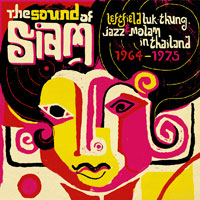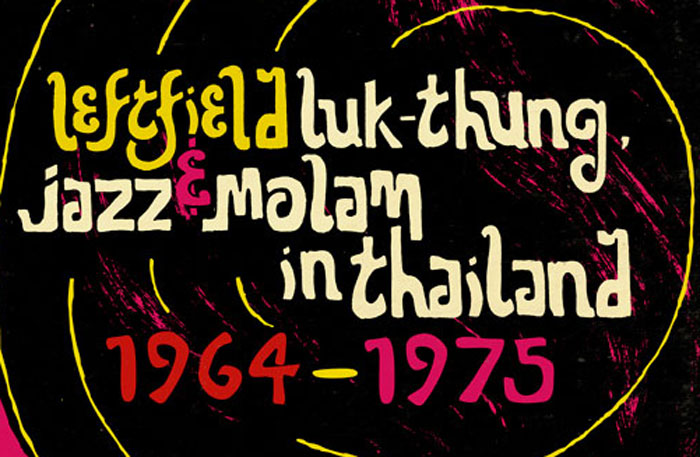Each week, World in Stereo examines classic and modern world music while striving for a greater appreciation of other cultures.
 Various artists: The Sound of Siam: Leftfield Luk Thung, Jazz & Molam in Thailand 1964-1975 (Soundway, 11/29/2010)
Various artists: The Sound of Siam: Leftfield Luk Thung, Jazz & Molam in Thailand 1964-1975 (Soundway, 11/29/2010)
Chaweewan Dumnern: “Sao Lam Plearn”
[audio:https://alarm-magazine.com/wp-content/uploads/2010/11/Sao-Lam-Plearn.mp3|titles=Chaweewan Dumnern: “Sao Lam Plearn”]In characteristic Soundway Records fashion, the crate-digging UK label’s newest compilation documents a flourishing music scene that few people even knew existed. Over the years, Soundway has released a number of afro-centric compilations filled with rare gems and obscure grooves, but its newest is an unexplored taste of Asia with The Sound of Siam: Leftfield Luk Thung, Jazz & Molam in Thailand 1964-1975.
The 19-track set is a fascinating exploration that spans North and South Thailand (known as Siam until 1939). It’s a retrospective that reveals one of the most experimental time periods in Thailand’s music history. Scouring the old and forgotten vinyls of Bangkok and unearthing the genres of luk thung, molam, funk, and spaced-out jazz, The Sound of Siam will surprise listeners with moving vocal performances, groovy rhythm sections, and surf-rock guitar riffs while being entirely Thai and Western chic at the same time.
Beyond Phuket’s beautiful beaches and Bangkok’s Khaosan Road, there lies a rich musical history that has seen little to no interest. Thailand, situated between Myanmar to the west, Malaysia to the south, and Laos and Cambodia to the east, has a traditional music history that encompasses the ethnic groups who occupy its geographical setting but have roots in its neighboring countries. Traditional ensemble instruments are strikingly similar between these countries, showing interrelated gong- and chime-music cultures accompanied by indigenous fiddles and oboes.
The sounds coming out of this album are so dynamic and vibrant; it’s hard to imagine that anyone who digs funk-, soul-, or jazz-laden music would not be astounded by at least half of the offerings, if not all of them.
But perhaps the fact Thailand was the only Southeast Asian country to never see European rule sets it apart from the rest of the area. Never colonized, Thailand viewed the West very differently than its neighbors. The majority of Thai people never resisted westernization because it was never associated with colonialism, making possible their long-running love affair with the West, both European and American. Subtle influences found their way into every sect of Thai life that culminated with the Siamese Revolution of 1932, when the government system in Siam adopted a constitutional monarchy similar to the United Kingdom, ending more than 700 years of absolute rule.
After the 1932 coup (in some sort of unbelievable reversal of imperialistic madness), the subsequent military regimes actually encouraged the incorporation of Western culture. In the cities, customs changed: everyone began wearing shoes, men started wearing hats and ties, women wore their hair longer, and government-sponsored programs encouraged social dancing – the cha-cha, tango, swing, and other dances became fashionable. This is why Western-influenced music arrived surprisingly early in Thailand. The early part of the 20th Century witnessed jazz and funk-influenced music becoming widespread in Bangkok.
The Sound of Siam is best at showing when and how luk thung and molam took their crucial turns in style and aesthetics. Both genres have basically the same musical agenda but come from different regions: luk thung is viewed as a more national style, whereas molam is originally the traditional song of Lao, which made its way into Thailand through the Northeast Isan region. They are multifaceted folk styles, coming in different tempos and rhythms with lyrical content that deals with the hardship of rural life.
The record documents the time period when luk thung and molam moved from countryside to the bustling city, when the younger generation took these traditional forms and tweaked them, where the two genres would eventually crisscross and evolve into various forms of popular mainstream Thai pop heard today.
The years that The Sound of Siam chose to cover, 1964 to 1975, are by no means arbitrary. The decades following the Siamese Revolution were a progressive time for West and Thai music to fuse, but it was really during these years that Thailand’s modern musical genesis occurred. Listeners of this record will be able to experience the music in quite a raw form, and deservedly so, as these mid-1960s and -’70s recordings were probably done live, before improvements in studio equipment and the advent of the cassette tape reached Thailand.
But that didn’t stop musicians from experimenting with new sounds and instruments that were making their way into the Thai repertoire. Electric guitars and organs made a deafening entrance into the music scene, adding new dimensions to traditional folk instruments such as the khene (Lao mouth organ made of bamboo) and phin (Thai lute).
“Lam Toey Chaweewan” by Chaweewan Dumnern is the album’s earliest example of this hybrid music taking shape; the beginning guitar riff is laced with reverb while the song playfully jibes with tradition but sounds entirely new. Later, Dumnern offers one of the more indispensable tracks on the compilation “Sao Lam Plearn,” showcasing a dirty Rolling Stones guitar riff over some strange, unrecognizable high-pitched effects. Like on many of the songs, the intro proves to be epic as Dumnern riff raffs a cappella over 15 bars in a vocal aesthetic that may prove cumbersome to the Western ear.
The sounds coming out of this album are so dynamic and vibrant; it’s hard to imagine that anyone who digs funk-, soul-, or jazz-laden music would not be astounded by at least half of the offerings, if not all of them. Many stunning pieces speak to different directions and styles from the emerging generation that made these sounds possible. From the funk-flavored molam of Saknatee Srichiangmai’s “Nom Samai Mai,” to the righteous groove section in P. Promdan’s “Wan Maha Sanook,” to the astonishing avant-garde cool-jazz sound of the Viking Combo Band’s “Pleng Yuk Owakard,” the tracks are truly forgotten gems, brought to new light with a fresh new perspective.
In many ways, it is a short-lived era of music. Just a mere five years later, the first wave of synthesizers hit Thailand, and a dance-ready electronic formula of luk thung was readily made. Moreover, Thailand’s obsession with the West became more and more scrutinized from the Thai, as music imports became so widespread that traditional Thai music began losing its place in culture. But make no mistake, The Sound of Siam is not some Western pastiche. Instead, it is a dense snapshot of a culture on the move, a musical paradigm shift at its peak, a handing down from old to new, and a traditional music breaking its way into a modern era.

